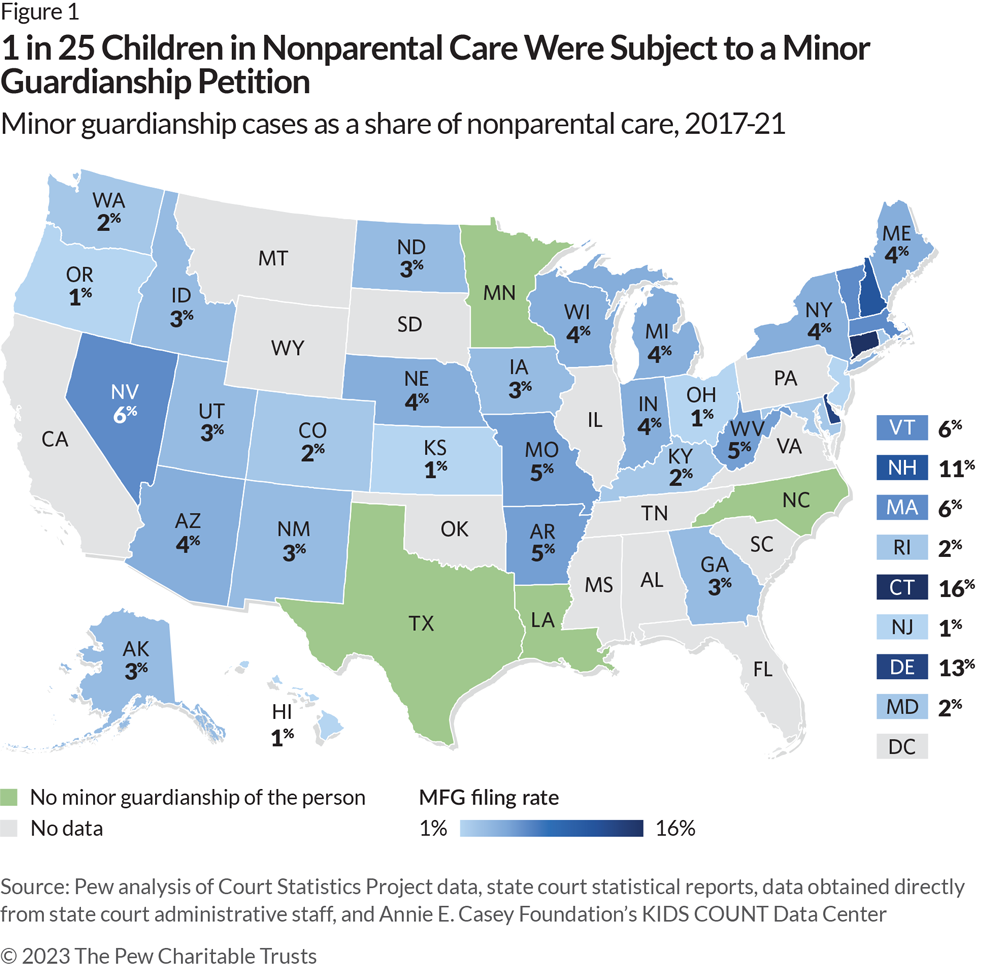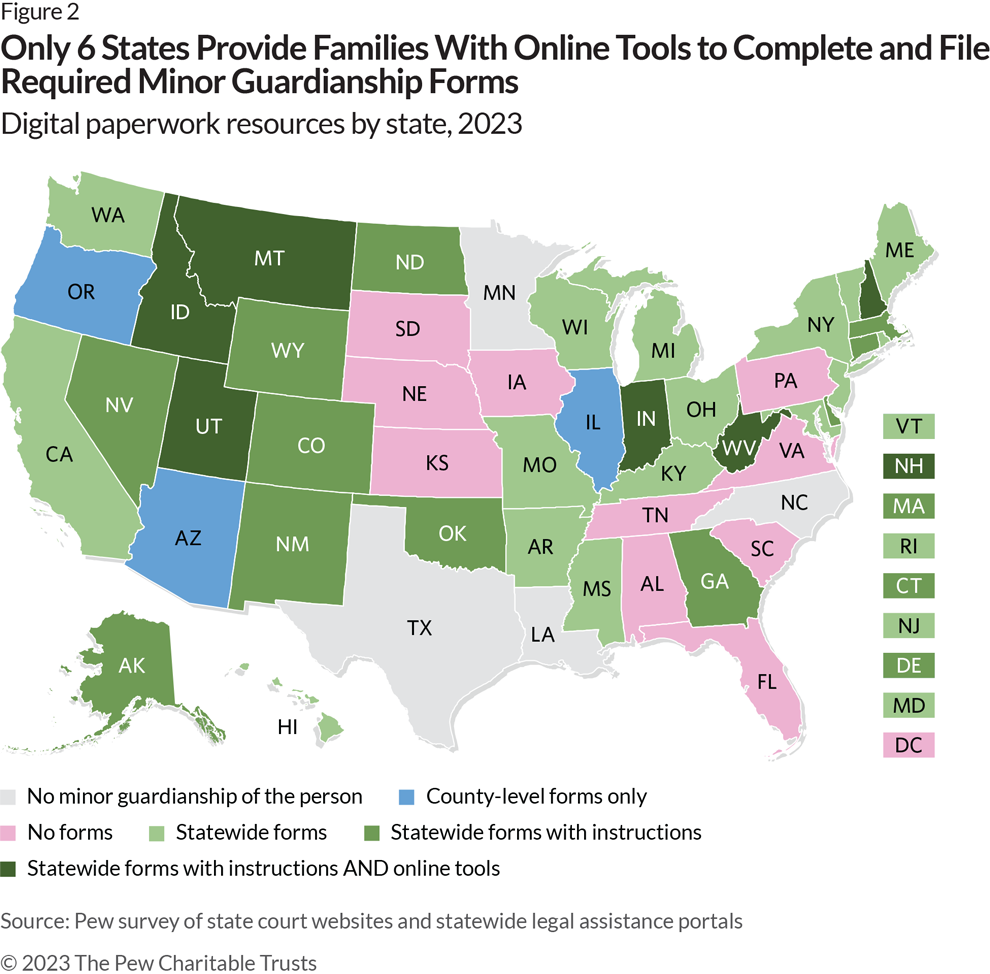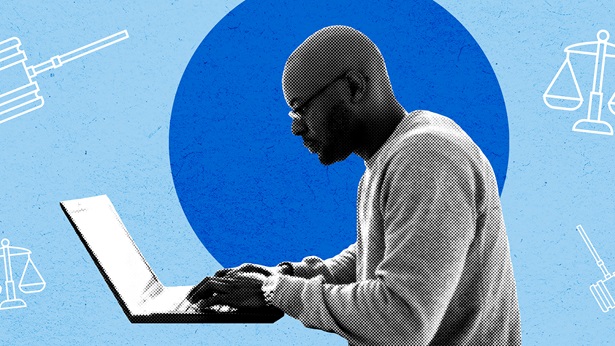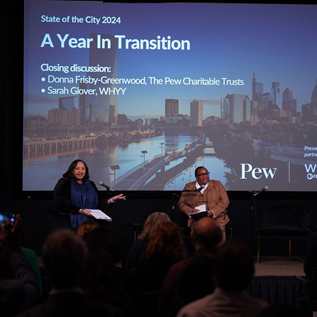Outdated Court Policies Can Leave Children Without a Legal Guardian
States can improve court access and effectiveness for families in need of stronger caregiving arrangements

Overview
Nationwide, about 3.7 million U.S. children—1 in 20—live in a household without a parent as their primary caregiver.1 Many are cared for by grandparents or another family member or friend (commonly referred to in the child welfare field as “kin”), and these nonparents routinely provide children with safe, stable environments when their parents are unable or unwilling to do so.
But nonparents do not have automatic legal authority to make critical decisions, such as those regarding a child’s school enrollment or medical treatments. One path that nonparents can pursue to secure that authority is “minor guardianship,” also known as “child guardianship”—a legal relationship, granted by a court, that confers the rights and responsibilities to care for a child upon an adult who is not the child’s parent.2 Historically, courts primarily granted minor guardianship upon the death of a child’s parents. But legal guardianship status has expanded, especially since the late 20th century, to include cases in which living parents cannot or will not take responsibility for their children, often because of poor health, incarceration, substance use, or military deployment.
Forty-six states and Washington, D.C., allow courts to grant minor guardianships for children whose parents are alive. However, in many of these states, families facing time and emotional pressures and seeking a pathway to security, safety, and stability for children find an obstacle course of complex and costly policies and procedures. And because many are unable to afford an attorney, they must navigate these processes alone.3 Families in these cases face a similar set of hurdles as unrepresented individuals in other types of civil cases do, such as a lack of plain-language information about their legal options and user-friendly resources to help them effectively participate in their case and assert their rights.4
But some of the barriers that nonparents encounter when seeking minor guardianship differ from those in other types of cases that frequently involve people without lawyers, such as debt collections and evictions. Most significantly, in minor guardianship cases the unrepresented litigants are typically the petitioners—the individuals who initiate the cases and, usually, who wish to become the guardians—whereas in debt claims and evictions, they are almost always defendants.
In minor guardianship cases, petitioners are responsible for a set of detailed legal tasks—such as filing the case with the court and notifying all relevant parties—that in other civil cases are completed by the plaintiffs’ attorneys.5 And these steps, often undertaken without legal help or expertise, are high stakes. Any errors can delay a hearing or result in dismissal of a case, putting children at risk because relatives and other nonparent caregivers do not have the legal authority to address children’s needs.
The Pew Charitable Trusts sought to help state court leaders and policymakers better understand and respond to challenges in minor guardianship cases, especially in light of the federal Families First Prevention Services Act of 2018, which made keeping children with family members—as opposed to foster or other “stranger” care—a national priority. Pew’s team reviewed research, state-level policies, and available court data, and it conducted interviews with child guardianship scholars, practitioners, advocates, attorneys, and court personnel.6 Pew’s analysis found that:
- Few of the nation’s millions of nonparent caregivers seek an order of minor guardianship. Throughout the 33 states with available data, petitioners sought guardianship for just 1 in 25 children under nonparental care. Rates varied by state: Only three states—Connecticut, Delaware, and New Hampshire—had cases for at least 11% of children in nonparental care, and the remaining states ranged from 1% to 6%.
- Just 22 states provide comprehensive easy-to-understand information online about minor guardianship. Nonparents can use several legal strategies to address urgent child caregiving needs, of which minor guardianship is just one. Before seeking a guardianship, however, nonparents must first know that the option exists, what it entails, whether they are eligible for it, and how it compares with other legal options offered in their state. Most states do not provide this level of detail on statewide court or legal aid websites, and of those that do, only nine also provide information about alternatives to minor guardianship. Further, nonparents without lawyers who want to pursue minor guardianship must identify and fill out required court forms and navigate complex legal processes. But in 29 states and Washington, D.C., statewide court or legal aid websites do not offer plain-language instructions for completing the forms. Of the states that do provide this information, only six offer digital tools to help unrepresented litigants accurately fill out or file required paperwork.
- Most states do not hear minor guardianship cases in the same court systems that handle other cases involving children. In 51% of states, the courts that handle child guardianship—often probate courts—primarily focus on issues unrelated to child care and are staffed by clerks and judges whose expertise is not in family law. These courts also may not have the family-support resources and funding commonly provided to family or juvenile courts. Moreover, if a child is involved in a case related to custody or abuse and neglect in one court and a minor guardianship case in another, the family must navigate multiple courts’ rules, processes, and procedures to resolve matters for the same child. And to further complicate this situation, just 19 states have minor guardianship laws that specify how probate courts should handle situations in which they and a juvenile court or child welfare agency are involved in separate litigation related to the same child.
- Minor guardianship orders do not always clearly outline parents’ roles and responsibilities. In many states, statutes and, as a result, court orders can be ambiguous about critical details, such as parental visitation rights while a guardianship is in effect—which can create confusion, conflict, and stress for families and additional demands on court resources. Laws in 19 states provide guidance on parent-child contact, but only 11 states have statutes that require or authorize judges to outline the role and responsibilities of a living parent in the guardianship order.
Pew also found that these challenges are not insurmountable, and several states already have made some progress in addressing policy and procedural challenges related to child guardianship. But states need to implement comprehensive changes to truly help families provide the care that children need. Court leaders and policymakers can take three key actions to begin tackling challenges related to minor guardianship and better position the courts to serve families:
- Examine court data to identify minor guardianship case trends. To better understand the pain points that litigants and courts encounter in minor guardianship cases and make informed decisions about problems to address, court leaders should analyze trends on petitioner characteristics (e.g., relation to the child, legal representation status); reason(s) for the petition; rate of contested guardianships; case outcomes and, where applicable, rationale for the court’s decision—e.g., case dismissed because of paperwork errors; rates of petitions to modify or terminate a guardianship.
- Review the steps of a minor guardianship case and the resources available to unrepresented litigants. Courts should provide nonparent caregivers and families with the information and tools they need to make expedient, informed choices about whether to pursue minor guardianship; accurately complete the required steps; and understand and execute the terms and conditions outlined in a guardianship order. Courts should take an inventory of the resources available to litigants for each step of the case—from deciding whether to seek a minor guardianship to adhering to the rules and processes of the court order—and create or modify materials for litigants without attorneys, such as incorporating more plain language in court forms.
- Examine minor guardianship statutes. State legislatures should review their minor guardianship statutes to identify inadequate guidance or clarity on whether guardianship can be used, especially for children with living parents; how courts should adjudicate minor guardianship; and the roles, rights, and responsibilities of the petitioner and the parent at every step (e.g., who must present evidence in court, what happens if a parent cannot be reached, who sets the terms for parent-child contact under a guardianship order). Legislatures should establish a working group of court personnel, legal aid providers, child welfare agencies, families, and other stakeholders to share their expertise and experiences in these cases.
By studying child guardianship and identifying better ways of serving nonparent caregivers and families, state courts can help families find the legal information and support necessary to effectively meet children’s most critical needs. This report explores minor guardianship cases; the policies, processes, and technological approaches that some states have adopted to improve how families and the courts interact and to ensure that outcomes are in children’s best interest; and the ongoing challenges facing nonparent caregivers, families, and courts.
Methods
This study involved a four-step approach to examine case and policy trends and challenges for court users throughout the 50 states and Washington, D.C.:
- A review of approximately 190 articles on child welfare—from academic journals, government agencies, nonprofit organizations, and other sources—that relate to minor guardianship and nonparent caregiving.
- Semistructured interviews with judges, private and legal aid attorneys, guardianship and nonparent caregiving advocates, and scholars, with a particular focus on four states that employ different structures for hearing minor guardianship proceedings: Nevada, Vermont, Washington, and Wisconsin.
- An analysis of state minor guardianship laws identified through Lexis, an online legal research platform.
- A comparison of minor guardianship caseloads with rates of nonparent caregiving from 2017 to 2021, using National Center for State Courts’ Court Statistics Project data, annual state court statistical reports, court data provided directly to Pew, and The Annie E. Casey Foundation’s KIDS COUNT database of nonparent caregiving data.7
Pew researchers verified policy and caseload data with all 50 states and D.C. for accuracy and executed additional quality control steps to minimize errors and bias. For more information, see the full methodological appendix.
What are nonparental care and minor guardianship?
In 2021, approximately 5% of U.S. children (3.7 million) lived in households where their parents were not present full time as their chief caregivers.8 Parents may be unable or unwilling to take primary responsibility for their children because of severe physical or mental health problems, incarceration, substance use, death, or military deployment, among other reasons.9
Children living without their parents are commonly cared for by kin.10 From 2005 to 2015, the number of children being cared for by grandparents grew more than 10 times faster than the total number of children in the general population, regardless of caregiving status (13% versus <1%), reaching approximately 2.9 million.11 And grandparents are providing care for longer periods: In 2018, about 46% of grandparent caregivers had cared for their grandchildren for five or more years, up from 37% in 2005.12
Caring for a child necessitates making and authorizing key decisions, such as consenting to or declining medical treatments and enrolling in school. But nonparent caregivers (including kin) do not automatically have the legal relationship to children under their care that is required to make many of those decisions or to keep a child under their care when an unfit parent seeks to reclaim the child. The U.S. Supreme Court in a series of cases, along with various state laws, has defined the rights of parents to direct the care, upbringing, and education of their children, as well as parents’ responsibility to provide routine physical care, protection, and support, but these rights and responsibilities do not automatically transfer to a nonparent caregiver.13 They can only be obtained by pursuing legal caregiving arrangements.
When a parent is unable or unwilling to care for a child and a nonparent needs legal authorization to temporarily or permanently take on parenting responsibilities, one option is to petition the state court for an order of minor guardianship.14 A minor guardianship order grants the nonparent many of the rights and duties that customarily would reside with the child’s parents—such as providing a safe and stable home, adequate food and clothing, education, and health care—as well as the authority to consent to school enrollment and health-related services and to make other decisions on behalf of the child.
Importantly, minor guardianship is fundamentally different than “permanency guardianship.” Both involve a court order granting an individual adult caregiving and custodial rights and responsibilities for a child. But in the former, the state is not a party to the case, while in the latter—which is invoked for children who have been declared dependents or wards of the state—the state, typically via the child welfare agency, is one of the litigants.
Minor guardianship grants nonparent caregivers legal custody of a child without involving the state’s foster care system or going through the adoption process. A minor guardianship order also can help establish terms for the parents’ appropriate level of involvement in the child’s life, such as visitation, child support, and decisionmaking authority.
In most states (36) minor guardianship falls under probate laws, which regulate the handling of a deceased person’s assets, because its original purpose was to empower probate courts to appoint a guardian to oversee the care and inherited property of a child whose parents passed away. But in many minor guardianship cases today, one or both parents are alive and have intact parental rights, and petitions commonly seek care of the child rather than an inherited estate.15
Pew’s analysis found that laws in 46 states and D.C. allow nonparent caregivers and families to petition for minor guardianship of a child whose parents are not deceased, but many of those laws still do not adequately explain the parents’ roles, rights, and responsibilities at each stage of the court process. This lack of statutory guidance creates a range of problems for families, caregivers, and courts. For instance, courts may need to effectively retrofit laws designed for guardianship of estates or minor orphans to accommodate cases involving children with living parents, which can create uncertainty, and even conflict, for nonparent caregivers and families around sensitive provisions, such as the terms of parent-child contact. It also may impede the courts from providing minor guardianship litigants with the resources they need.
The steps of a minor guardianship case
Although the details of court processes vary in each state (and sometimes each county), nonparent caregivers and families seeking minor guardianship generally follow these steps:
- Find and review information on legal caregiving. Prospective petitioners must first learn about their legal caregiving choices, including minor guardianship, their eligibility for the various arrangements, and the actions required to obtain them. Nonparents and families may begin searching for information about caregiving options in venues other than the courts, such as a child welfare agency or kinshipcare support organization. But once in need of legal guidance, they are likely to turn to a private attorney, legal aid provider, court website, or self-help center.
- File a petition. A petitioner—typically a prospective guardian but occasionally parents or even the child—files a form requesting and stating the reason for appointment of a guardian with the state or county court that has jurisdiction in these matters, usually probate, family, or juvenile court.16
- Send notification (aka “Service of Process” or “Service”). The petitioner officially informs relevant parties about the filing, typically all living parents and, depending on the state, the child, grandparents, the child’s current nonparent guardian if applicable, the relevant child welfare department, the appropriate Tribal government if the child is Indigenous, and all others required by statute or the court.
- Attend hearing(s). In most cases, the court holds an initial hearing for the judge to review the petition and other documentation from the petitioner; determine whether required steps, such as notification, have been completed; and ascertain whether all parties agree that a guardian should be appointed.17 If all steps are complete and the parties agree, the judge can typically render a decision quickly. If not, the judge may require more steps or schedule additional hearings.18
- Participate in post-appointment processes. If an order is granted, guardians may have ongoing interactions with the court, such as filing annual reports on the child’s well-being or attending hearings to modify or terminate a guardianship.
Once granted by the court, a minor guardianship order is usually in place until the child reaches legal adulthood (typically at age 18), but the specific duration can vary depending on the state. Additionally, an order can usually be modified or terminated if the court finds that the child’s circumstances have changed—for example, because the guardian has passed away or the parent has returned from a military deployment or resolved a physical or mental health issue.
Few of the nation’s millions of nonparent caregivers seek an order of minor guardianship
Throughout the 33 states in which minor guardianship case filing data was available, an average of 4% of children (1 in 25) in nonparental care were the subject of a minor guardianship petition from 2017 to 2021.19 But rates varied significantly: In three states—Connecticut, Delaware, and New Hampshire—at least 11% of children in nonparental care were the subject of minor guardianship cases; 13 states had rates between 4% and 6%; and the remaining 17 states had rates between 1% and 3%.20 (See Figure 1.)
Minor guardianship policy and procedural challenges
Despite the prevalence of children living with nonparents nationally, guardianships are not widely or evenly used across states, and the reasons for this low usage are largely unknown. One possibility is that some nonparent caregivers and families do not know about child guardianship or are using alternative legal caregiving pathways, such as becoming licensed foster care providers or, in some states, using consent forms that grant a nonparent caregiver limited powers related to a child, such as for school enrollment or medical decision-making. However, these alternatives cannot meet the needs of every family or nonparent caregiver and so likely do not, by themselves, explain the low usage of minor guardianship.
Another reason may be the legal process itself. Research shows that most kin caregivers are low income and probably cannot afford an attorney and that the rates of inadequate representation are high for individual litigants across several civil case types.21 Further, several legal aid providers interviewed for this study reported that the demand for their services exceeds their capacity. Court leaders and other legal stakeholders have long acknowledged that courts are generally poorly positioned to serve unrepresented litigants. And in some instances, courts may be constrained by state laws pertaining to how much help or flexibility they can offer.
Ultimately for many nonparents and families, the ability of the courts in their jurisdictions to provide information, support, and a clear resolution —and to do so in a timely and sensitive manner —may be a determining factor in whether to pursue a minor guardianship.
To identify and begin to address inefficiencies and pain points that nonparent caregivers and families may be experiencing, state court leaders and policymakers need a clear understanding of what is happening in minor guardianship in their states. But data on these cases is scarce. Pew examined minor guardianship statutes, case steps, and self-help resources to learn whether and where they fall short of helping nonparent caregivers and families understand their options, make informed decisions, and navigate the courts to get what they need to protect and care for a child. The analysis found that at virtually every step of the process, outdated state laws, inadequate resources, and onerous court processes and rules present barriers for families and nonparents without legal representation.
According to one Nevada legal aid attorney, “These are kids that need to be enrolled in school or need to see a doctor, yet a judge can deny the guardianship due to procedural issues. And these petitioners generally don’t have anyone to ask for help.”22
Nearly half of state courts do not provide information on legal child-caregiving remedies
Before filing anything in court, nonparent caregivers must know that minor guardianship exists; what it entails—including if multiple types are offered, such as a temporary guardianship that is time-limited for shorter-term child caregiving needs or a full guardianship that lasts until a child turns 18; whether they are eligible to become a guardian; and how minor guardianship compares with other legal remedies available in their state. (See Table 1.)
Table 1
States Offer Various Legal Child-Caregiving Options to Address Families’ and Nonparents’ Needs
Common legal caregiving arrangements and their terms
| Arrangement | |||||
|---|---|---|---|---|---|
| Minor guardianship | Adoption | Dependency/ foster care | Health/ education consent | Power of attorney | |
| Legal action | A court grants to a nonparent the rights and responsibilities to care for a child whose parents are unable or unwilling to do so. | A court terminates the biological parents’ legal rights and transfers to new parents the full responsibility for and rights to a child. | A court declares parents unfit, and their child becomes a ward of the state and is placed in foster care or with relatives, under the supervision of child protective services. | A sworn statement by a nonparent caregiver attesting to a parent’s absence that allows the nonparent to make certain medical or educational (e.g., school enrollment) decisions on behalf of a child. | A parent signs a legal document designating a caregiver with decision-making authority on behalf of a child, such as for medical care. |
| Requires living parents’ consent | X | ||||
| Requires severing the legal parent-child relationship | X | ||||
| Requires child welfare system involvement | X | ||||
| Requires a court hearing | X | X | X | ||
| Is eligible for public financial support | X* | X | X | ||
| Is eligible for social services support | X | ||||
| Grants physical custody | X | X | X | ||
|
*In virtually all states, guardians of minors are eligible for much less financial support than foster care providers. Note: “Requires” means that the factor (e.g., consent, child welfare involvement) is typically obligatory in every case throughout the U.S. Sources: Generations United, “State Educational and Health Care Consent Laws” (2014), https://www.americanbar.org/groups/public_interest/child_law/resources/ child_law_practiceonline/ child_law_practice/ vol-33/ june-2014/ state-educational-andhealth-care-consent-laws/; U.S. Department of Health & Human Services, “Child Welfare Information Gateway: Glossary,” https://www.childwelfare.gov/glossary/glossarya/ |
Providing legal information online is an important low-cost way that courts can help nonparent caregivers and their families who are not able to consult or hire an attorney to understand their legal options. But Pew found that only 22 states explain on their statewide court or legal aid websites what minor guardianship is and when it can be used, and only nine provide information about other legal caregiving solutions.23 Without user-friendly online resources, nonparent caregivers and families who cannot afford an attorney are likely to struggle to learn about and easily identify the best option to address their urgent child caregiving needs.
Most states do not provide instructions and tools for completing and filing required forms
Petitioners start a minor guardianship case or request changes to or termination of a guardianship order by filling out and filing court forms. But determining which forms are required, how to properly complete them, and when and where to submit them can be difficult for people without lawyers, especially when they are dealing with multiple forms brimming with legal jargon. For instance, before a hearing can even be scheduled in Wisconsin, petitioners must identify, fill out, and file at least five forms, which often necessitates multiple trips to the courthouse.24 Some states have developed online forms and document filing systems, but these tools are not all user-friendly and many are available only to attorneys.25
Pew found that among the states that allow minor guardianship proceedings for children with a living parent, 29 and Washington, D.C., do not provide online instructions for filling out the forms needed to file a petition.26 (See Figure 2.) Of those that do, only six—Idaho, Indiana, Montana, New Hampshire, Utah, and West Virginia—provide a digital tool on their statewide court or legal aid websites to help unrepresented petitioners accurately fill out or electronically file their forms.27
The lack of tools to help people complete paperwork quickly and accurately can lead to unnecessary delays in scheduling a hearing or even to dismissal of a petition, which in turn create inefficiencies for the courts and, most significantly, can prevent families from meeting children’s urgent needs. As one Wisconsin attorney said, “Sometimes just filling out all that paperwork is a huge obstacle in and of itself … people get their case thrown out because the paperwork wasn’t correctly filled out.”28
Although courts are responsible for the information and tools on their website, state legislatures can help courts improve their offerings by allocating funding for these resources in state budgets.
States require petitioners to complete difficult and costly notifications
After petitioners file a minor guardianship case, laws in virtually every state require that they notify all living parents and grandparents—as well as the child (if of a certain age, usually 12 or older)—about the petition in a timely fashion and at their own expense. But some state laws require petitioners to notify a far lengthier list of concerned parties, and failure to inform all required parties in the correct manner and within the allotted time can result in delay or even dismissal of the petition, leaving the child without essential care.
In Washington state, for instance, petitioners could be required to notify more than eight parties using costly methods—including through a paid process server and by mail—before a court hearing can be held:
- The child listed in the petition (if 12 years or older).
- Each parent, or if there is none, the child’s closest adult relative.
- Every person who has had primary care responsibility or custody of the child for at least 60 days within the past two years or at least 730 days within the past five years.
- Any person nominated as guardian by a minor child who is at least 12 years old.
- Any person nominated as guardian by a parent.
- The child’s grandparents, if applicable.
- The child’s adult siblings, if applicable.
- The conservator for the child’s estate, if applicable.
- Any other person identified by the court.29
And if these conditions are not met, the court may postpone the hearing until service is completed or a court investigator confirms that the parents cannot be served. Other states require that when direct service to certain parties cannot be completed, the petitioner publish a notification in a local newspaper, which can be expensive for the typical kinship caregiver.
Legal aid attorneys in several states explained that arduous notification requirements often lead to these kinds of additional expenses and delays. Most petitioners, they say, simply do not have the time, knowledge, or resources necessary to hire a process server, work with a county jail or state department of corrections to serve an incarcerated parent, or figure out what to do when a parent is in treatment and cannot be served because of medical privacy rules.
Service is an essential part of due process: Parents have unique rights and must be notified if someone else is seeking legal custody and decision-making authority related to their child. But service should not be so onerous that it interferes with urgent or ongoing child caregiving needs.
State laws are often vague about evidentiary requirements
As with all civil cases, courts rely on evidence to inform decisions on minor guardianship, and the responsibility to present evidence and testimony can fall on multiple parties. For example, if a parent opposes a guardianship petition, the petitioner must provide evidence showing why a guardianship order is warranted. But if the parent is seeking to terminate an existing order of guardianship, then in many states the evidentiary responsibility rests with that parent—particularly when the parent did not consent to the guardianship—to demonstrate that the original reason for the guardianship, such as a parental substance use disorder, has been resolved.
However, legal practitioners interviewed for this study reported that families and nonparent caregivers without lawyers often have difficulty figuring out what evidence is needed and how to effectively present it. For instance, Marina Dalia-Hunt, a legal aid provider in Nevada, said that unrepresented litigants routinely struggle to understand what evidence to present. “For a parent who underwent substance use treatment, what evidence do you show the court to prove that you no longer have an addiction problem? Do you need to have drug tests? There’s no clarity on what exactly Nevada state law deems sufficient evidence, and it makes it really hard for parents to navigate.”30 And these evidentiary requirements have significant consequences for litigants. As with the other procedural steps discussed, failing to offer sufficient, admissible evidence can lead to denial of a petition.
However, because state statutes cannot possibly detail every type of evidence that all parties to guardianship cases might have to provide, courts also have a critical role to play in supporting litigants without lawyers, especially by providing plain-language guidance on how to select and present evidence.
State laws and court orders are often unclear about the roles and responsibilities of parents within guardianships
Even after receiving a guardianship order, nonparent caregivers and families may still struggle with making critical child care decisions, particularly when the order does not clearly outline the parents’ roles and responsibilities. For example, if state laws do not specify who can set the terms of parent-child contact—such as the guardian or the court—then guardians and parents may find themselves back in the courtroom, and an already stressful family situation can become more contentious.
Only 11 states—Indiana, Maine, Mississippi, New Hampshire, New Jersey, New Mexico, North Dakota, Oklahoma, Vermont, Washington, and Wisconsin—statutorily require or authorize courts to outline parents’ roles and responsibilities, if any, when issuing guardianship court orders. But even in these states, the laws vary in their level of detail. Indiana’s law, for instance, grants judges the authority to set terms that a parent must meet before the order can be modified or terminated, but it does not include language about visitation rights, child support, or certain decision-making rights.31
And even when state laws provide clear guidance, court orders may not be written in plain language, and judges may not explain the orders’ content in an easily understandable manner. In these cases, families may leave the courtroom without a full understanding of how authority is distributed between the guardian and the parents.
Multiple courts can have jurisdiction over child welfare
Navigating the rules and processes of even one court case can be challenging for petitioners and families without lawyers. But in some states, families must find their way simultaneously through two court systems with different and even conflicting procedures to resolve legal matters related to a single child.
About half of states (51%) hear minor guardianship cases in a state or county court—often probate court—that is siloed from the family and juvenile court systems that handle other cases involving children. As a result, a child may, for instance, be involved in a custody-related or abuse and neglect case in family or juvenile court as well as a minor guardianship case in probate court. This not only can result in confusion, added costs, and duplication of effort for already-stressed families but also entrusts critical child care decisions to judges and court staff whose expertise is not primarily related to children and who may not have the same family-support resources and funding as family or juvenile courts.
Moreover, less than half of states (19) have laws that specify how courts should handle a juvenile court’s parallel involvement with a child subject to a minor guardianship petition. The rest do not provide guidance on which court order has precedence or require that courts coordinate when handling matters for the same child.32 For example, in California, after one child’s mother was incarcerated, the grandparents with whom the child was already living petitioned for guardianship in the probate court in Los Angeles. But two days later, the father filed an action in family court in Orange County seeking legal recognition as the child’s parent and was awarded custody before the Los Angeles court had ruled on the grandparents’ petition.33
Recommendations
Although significant, these challenges are not insurmountable. State legislatures and court leaders can address these problems and position courts to better serve children and families.
To start, court leaders should examine their state’s minor guardianship case data to better understand the experiences of people who interact with the courts, including which challenges are prevalent in a particular court. They should also review minor guardianship procedures and court self-help resources to identify improvements that could help nonparent caregivers and families better navigate the system.
State legislators—with guidance from courts, child welfare agencies, legal aid providers, and kinship advocacy organizations—should review minor guardianship statutes to identify where updates are needed to better equip courts to respond to families’ needs efficiently and effectively.
Examine court data
Pew researchers found that states publicly report very little data on minor guardianship, obscuring the nature and extent of the challenges that petitioners and families face. To better understand people’s court experiences and make informed decisions about how to address problems, court leaders should start by examining the following case data:
- Types of people petitioning for guardianship (e.g., grandparents, aunts/uncles).
- Reasons for petitions (e.g., to enroll a child in school, to prevent a parent from taking a child away from a caregiver’s home).
- Rates of guardianship types sought (e.g., emergency, full).
- Legal representation rates for petitioners.
- Legal representation rates for parents.
- Share of petitions that are contested.
- Number of hearings per petition.
- Time between filing and initial and final hearings.
- Case outcomes rates (e.g., granted, dismissed, denial).
- Reasons for denial or dismissal (e.g., failure of service, forms incomplete).
- Rates of petitions to modify or terminate a guardianship.
- Reasons for petitions to modify or terminate.
- Outcomes of modification or termination filings, and reasons for denial or dismissal, if applicable.34
For example, in 2015, the Iowa Supreme Court established the Guardianship and Conservatorship Reform Task Force to review the state’s guardianship laws and procedures and develop recommendations to make them more responsive to state residents’ needs. The task force began by examining relevant case data and found that 82% of guardianship petitions were related not to children whose parents were deceased but to those with living parents who were unable or unwilling to care for the child.35 This finding helped the task force identify a major gap in Iowa’s statutes: The state’s laws did not outline the criteria for granting a minor guardianship in cases involving living parents, leaving judges to rely on their own discretion. The task force recommended statutory changes to address this gap, which the Legislature passed in 2019.36
Court in Washoe County, Nevada, Uses Data to Improve Efficiency
Each month, the Second Judicial District Court in Washoe County, Nevada, publishes a report on its website that provides up-to-date information on the status, trends, and outcomes of minor guardianship cases in the county, including:
- Types and number of cases pending (e.g., full guardianship, temporary guardianship).
- Number of cases reopened.
- Types and number of guardianships granted in the past 12 months.
- Number of days between filing of the petition and the initial hearing for each case.
- Number of contested cases.
- Number of cases that went through mediation and their outcomes (e.g., successful, partial agreement, unsuccessful).
- Compliance rate with guardians’ annual reporting requirement for the past 12 months.
- Number of cases with court-appointed attorneys and investigators.
- Types and number of guardians (e.g., parent, grandparent, other relative, nonrelative).37
Judge Tamatha Schreinert, the court’s minor guardianship judge, and court staff use these reports to understand what’s working in their county, identify potential problem areas and strategies to address them, and manage the court calendar more efficiently. For example, according to the court’s May 2023 report, in the past 12 months, the court’s mediation program, which helps parents and guardians develop a plan for a child, had roughly a 70% success rate in getting families and caregivers to agree on a plan. Judge Schreinert said that tracking these success rates “helps my calendar a lot, because as soon as we learn that a mediation was successful, we can shorten the trial and fit more cases.”38
In addition, tracking compliance with filing annual guardianship reports has helped Judge Schreinert and her team identify when compliance faltered. In response, they partnered with the court’s resource center to make phone calls to guardians reminding them to file their reports, which led to a 5% jump in compliance. With this initial success, the team has connected with a text system to send guardians reminders to file their reports, and they will track its impact on compliance rates. Judge Schreinert said, “The statistics really do show us what’s working and where we need to focus our attention to improve efficiency with how we operate, manage these cases, and serve the public.”
Review minor guardianship case steps and self-help resources
Courts should be set up to enable all nonparent caregivers and families to make expedient, informed decisions about whether to pursue a minor guardianship, accurately complete the necessary steps, and effectively execute a guardianship order. To understand whether and how their state system is falling short of this goal, courts should review the steps required to seek a minor guardianship and the self-help resources available for each of those steps to identify opportunities for improvement.
For example, as part of its work, the Iowa Supreme Court’s guardianship task force reviewed the procedures people had to follow when seeking a minor guardianship. To better support petitioners, especially those without attorneys, the task force recommended that the court create a standardized petition form that is “written in plain language, easily readable type, and understandable by persons with different educational levels and from different backgrounds,”39 and make it, along with filing instructions, readily available online.
Although determining the number of state courts that have conducted such a review was outside the scope of this study, Pew researchers did identify several court resources and tools aimed at helping unrepresented litigants in these cases. For example, on the Delaware Courts homepage, users can find a quick link to the court’s self-help website, which contains easily digestible information explaining what minor guardianship is, who can become a guardian, and the types of minor guardianship available in the state.40 The self-help page also includes plain-language instructions for completing each step of a minor guardianship case.41 Armed with this information, nonparent caregivers and families can make informed decisions about whether minor guardianship is right for their situation and how to move forward.
And in Utah, the state courts’ self-help website provides plain language information about alternatives to minor guardianship, the types of guardianship available, case steps, and a tool to help unrepresented litigants identify and fill out the court forms required for their case.42 This resource simplifies the process for petitioners, saving them the time and frustration of trying to understand and complete complex legal documents on their own, or having their case dismissed or delayed because of paperwork errors.
Review minor guardianship statutes
States need to evaluate their statutes to determine whether they are compatible with the contemporary use of minor guardianship, particularly for situations involving living parents. Specifically, state legislatures should examine whether minor guardianship laws are sufficiently clear on:
- The conditions required for a court to authorize a minor guardianship in cases where parents consent to a guardianship and in cases where they do not.
- The types of minor guardianship available to families.
- Which parties must be notified of a minor guardianship petition, how service must be made, and what to do if living parents cannot be located.
- Evidentiary requirements for guardianship petitioners.
- Which courts have jurisdiction and which orders have precedence when a child is involved in multiple cases.
- The terms and conditions of a parent’s role (e.g., parent-child contact, child support) that a minor guardianship order must include.
- The circumstances under which a guardianship order can be modified or terminated, including who needs to present evidence to the court to justify a modification or termination.
Legislatures in several states have formed task forces or related groups made up of court leaders, legal aid providers, and child welfare agencies and advocates. These groups have recommended improvements to minor guardianship procedures and shared their knowledge about the challenges families encounter in these cases; the policies associated with those challenges; the self-help tools and programs available to assist families without legal representation; and how systemic problems might be addressed.
Vermont’s Legislature, for example, established a committee in 2011—composed of state judges, legal aid practitioners, child welfare agency staff, and advocates for families and children—to study minor guardianship proceedings, which are heard in probate courts, including what procedural changes would best serve the interests of children.43
The committee recognized that the statutes governing minor guardianship had not been comprehensively revised since the 1920s and were not working well for families, particularly when living parents were involved. For example, the laws lacked clear guidance for courts about when they could authorize a guardianship and how to structure the role and rights of the parent, including parent-child contact in cases when a parent consents versus those when a parent objects. The laws also did not assure that concurrent cases in probate and family court involving the same child were routinely consolidated under one court.
The committee issued several recommendations to address these concerns, and in response, the Legislature passed a bill, which took effect in 2014, to clarify requirements for evidence at every step of both consensual and nonconsensual minor guardianship cases and for transferring a guardianship case to family court when cases co-occur in multiple courts.44 As one committee member, the then-executive director of a parent advocacy organization, said, “We changed the law so the criteria of who needs to provide evidence that a minor guardianship is or isn’t needed is clear. But often in minor guardianship cases no one has a lawyer, no one really understands the legal process. And probate judges with no experience in family law may not have the training on the needs of families and how to work with unrepresented litigants in these cases.”45 Legal scholars and practitioners interviewed for this report cited the statute as a model law that other states could follow.
Wisconsin’s Legislature formed a committee in 2018, and it found that the state’s existing minor guardianship laws under the probate code were not responsive to the needs of children being cared for by nonparents. As a result of the committee’s work, the Legislature passed a bill in 2019, which took effect in 2020, that made changes similar to those in Vermont, but with two notable differences. First, the bill transferred jurisdiction for minor guardianship of a child (not an estate) to the state’s children’s court and created a new governing statute.46 Second, the bill expanded the types of guardianship available (previously there had only been “temporary” and “full” designations) to better meet various needs:
- 60-day emergency—allows the guardian to make decisions in an acute situation, such as a medical emergency when parents are not available or able to consent to treatment.
- 180-day temporary—provides the guardian with short-term custody and decision-making authority when parents are unable to provide care, such as when a parent is undergoing medical treatment or is incarcerated for a short time.
- Limited—grants a guardian selected decision-making and caregiving rights for a proscribed period, such as making routine medical and educational decisions when a parent needs help caring for a child, and may allow the parent to retain some decision-making authority or share physical custody of the child.
- Full—grants a guardian comprehensive legal authority, equivalent to parental rights and responsibilities, to make decisions until the child turns 18.
Former Wisconsin state representative and committee chair Jim Steineke said, “The beauty of the committee was bringing in experts from all different sides of the issues to figure out what the problems were and what we could do as solutions. I would just advise anybody working on this issue, especially legislators, to work with everybody—Democrats, Republicans, judges, advocates, families, academics. These aren’t partisan issues. These are issues about kids’ health and safety and their ability to have a successful life.”47
Conclusion
Pew’s research indicates that many state laws and court systems are not working well for children in the care of a nonparent, the caregivers, or the parents. Outdated and confusing minor guardianship statutes and procedures can be costly and create confusion and conflict for nonparent caregivers and families, many of whom do not have an attorney, as they try to address urgent child care needs.
Although some states have sought to better understand and address the challenges nonparent caregivers and families face, they can do more to help unrepresented litigants effectively use the courts to seek guardianship. State policymakers and court leaders, in partnership with minor guardianship practitioners, community stakeholders, and families, can take a range of steps—beginning with conducting comprehensive reviews of the data, case steps, self-help resources, and statutes related to minor guardianship in their jurisdictions—to identify where existing policies and procedures fall short and develop reforms to ensure that nonparent caregivers and families can provide safe, stable environments for vulnerable children.
Appendix A: Methodology
For this study, Pew researchers conducted a literature review and analyzed state-level policies, legal information websites, and court caseload statistics related to minor guardianships throughout the 50 states and Washington, D.C. The researchers also conducted interviews with minor guardianship and child welfare scholars, advocates, and providers.
Literature review
The review of minor guardianship proceedings and nonparent caregiving literature used keyword searches on four engines—EBSCO, HeinOnline, Google, and Google Scholar. The search terms included but were not limited to: “minor guardianship,” “guardianship of minor,” “nonparent custody,” “kinship care,” “grandfamilies,” and “probate code reform.” The researchers also reviewed studies available on the websites of 15 organizations involved with minor guardianship and nonparent caregiving. These searches generated approximately 190 academic and gray literature articles, which were reviewed for relevancy and coded to identify common characteristics and themes in minor guardianship proceedings.
Policy analysis
Pew researchers took a multistep approach to identifying trends in policies related to minor guardianship cases. First, researchers used Lexis to collect probate/estate, judiciary, family/domestic relations, and social welfare laws in all 50 states and D.C. in effect as of Dec. 31, 2022. They then searched each to identify the laws related to minor guardianship using the following search terms: “minor guardianship,” “guardian of minor,” “guardianship of a child,” “third-party custody,” and “non-parent custody.” A complete list of these laws by state and relevant citations is available in Appendix B.
Using results of the literature review and input from an external minor guardianship policy expert, the researchers developed a list of common characteristics with which to code each law. The initial coding protocol was applied to a few state laws to test whether the codes were clear or whether common characteristics were missing or needed to be split up. The research team applied the final coding protocol to the collected laws and captured the following for each jurisdiction:
- Section of the state statute that housed these laws.
- Court that has jurisdiction over minor guardianship cases.
- Persons who are eligible to petition for guardianship.
- Criteria for serving notice of the petition.
- Parties that must be served notice of the petition.
- Criteria for the court to appoint a minor guardian.
- Whether and how laws specified living parents’ role in minor guardianship proceedings.
- Role of the juvenile court and public child welfare agency in minor guardianship cases.
To identify recent changes to policies, researchers used bill tracking software to find bills related to minor guardianships that had passed between Jan. 1, 2018, and Dec. 31, 2022. Search terms used to identify appropriate bills included “minor guardianship,” “guardianship of minor,” “guardianship,” “kinship,” “family court,” “probate court,” and “grandfamilies.”
Website analysis
To assess the online availability of legal information and forms related to minor guardianship, Pew researchers scanned websites for at least one state-level court and one statewide legal assistance portal from all 50 states and D.C. The researchers examined the legal information or self-help sections of these websites to identify whether they provided minor guardianship procedural information and forms. Finally, the researchers referred to the court or legal information websites to determine which courts heard minor guardianship cases in each state.
Court caseload and KIDS COUNT data analysis
To identify the volume of minor guardianship cases filed in each state, Pew researchers relied on a combination of caseload data from the following sources, in order of precedence: state court staff through correspondence with Pew researchers (eight states), courts’ online annual reports or dashboards (16 states), and the National Center for State Courts’ Court Statistics Project (nine states).
Pew researchers were able to obtain data on annual minor guardianship filings for at least one year between 2017 and 2021 for 33 states and used those filing counts to generate the average annual filing number throughout the 33 states. The research team then used that figure in subsequent analyses.
To calculate the minor guardianship filing rate, the researchers used the “children living with neither parent” variable from The Annie E. Casey Foundation’s KIDS COUNT Data Center as the denominator.48 The team averaged annual counts for the variable by state from 2017 through 2021 to achieve as much comparability as possible with the minor guardianship caseload data. The KIDS COUNT Data Center defines this variable as: “Children are not living with a parent if the reference person for the household does not identify them as a biological, adopted, or stepchild of the householder or as a child in a subfamily as determined by the Census Bureau. This includes children who are related to the householder as siblings, grandchildren, and foster children. Children are also included if they are the householder or the spouse/partner of the householder, a roommate, or other nonrelative of the household. Children living in group quarters are categorized as not living with a parent.”49
The KIDS COUNT Data Center also includes biannual data on the number of children in kinship care by state—defined as “situations in which children are cared for full-time by blood relatives or other adults with whom they have a family-like relationship, such as godparents or close family friends.”50 But Pew’s researchers chose to use the nonparent case variable because it includes children in foster care and living in group quarters, and because it was collected annually, rather than every two years, making it more compatible with the annual minor guardianship case filing data from the courts.
Interviews
To collect additional insights on minor guardianship case trends and challenges, the researchers performed semistructured interviews. The interviewees included two scholars and two representatives of national organizations focused on nonparent caregiving, as well as a group of 11 stakeholders—two judges, two private practice attorneys, and seven legal aid and kinship caregiving practitioners—from five states: Nevada, North Carolina, Vermont, Washington, and Wisconsin. Four of the states—Nevada, Vermont, Washington, and Wisconsin—were chosen because they represent a range of structures for minor guardianship proceedings. North Carolina does not have minor guardianship proceedings but was included to gather insights on private, legal, nonparent caregiving options. Findings from the interviews are not generalizable and were used primarily to add substance to the results of the literature review and the policy and data analyses.
Quality control
Pew researchers shared state-specific findings from the policy, website, and court caseload analyses with court administrative staff in all 50 states and D.C. to verify their accuracy. The researchers then updated data and analyses where states identified inaccuracies and provided information or links to the correct data. An unaffiliated third-party researcher reviewed all quantitative analyses, and the report underwent an independent fact check.
Limitations
This study has three key limitations. First, its scope is limited to states with policies that allow a nonparent to independently petition for guardianship of a child with a living parent and does not account for states that do not allow minor guardianship petitions in situations involving living parents but do allow them through other case types (e.g., third-party custody). This latter group of states was omitted because further research is needed to understand the differences in proceedings across case types and the policy and procedural challenges of each.
Second, this study focused on state-level policies and state court procedures and did not assess policies or procedures at the county level. Therefore, any challenges that nonparent caregivers and parents face associated with differing rules and procedures among county courts are not captured in this report.
In addition, Pew’s policy analysis was limited to the language in each state’s statute. This study also did not assess how courts apply statutory policies in practice or the effects of court rules, case law, and legal precedents on how these cases are adjudicated. These would be important elements for policymakers, researchers, and court leaders to examine when considering the effectiveness of policies.
Appendix B: Minor guardianship statutes
Table B.1
Statutes Governing “Minor Guardianship of the Person” in the 50 States and Washington, D.C., Analyzed for This Study
| State | Statute | State | Statute | |
|---|---|---|---|---|
| AL | AL Code § 26-2A-73; 75; 81 | MT | MT Code § 72-5-222; 225; 234 | |
| AK | AK Stat. § 13.26.132; 147; 186 | NE | NE Rev. Stat. § 30-2608; 2611; 2616 | |
| AZ | AZ Rev. Stat. § 14-5204; 5207; 5212 | NV | NV Rev. Stat. § 159A.044; 061; 0565; 1915 | |
| AR | AR Code § 28-65-105; 207; 214; 219 | NH | NH Rev. Stat. § 463:06; 10; 13; 15; 80 | |
| CA | CA Prob. Code § 1511; 1513; 1514; 1601; 1602 | NJ | NJ Rev. Stat. § 3B:12A-3; 4; 6 | |
| CO | CO Rev. Stat. § 15-14-204; 210 | NM | NM Stat. § 40-10B-4; 5; 8; 12 | |
| CT | CT Gen. Stat. § 45a-610; 611; 612; 619 | NY | NY CLS SCPA § 1702; 1705; 1707 | |
| DE | 13 DE Code §2321; 2330; 2331; 2332; 2333 | NC | NC Gen. Stat. § 35A-1221; 1224; 1295 | |
| DC | DC Code § 21–101 | ND | ND Cent. Code § 27-20.1-02; 08; 11; 12; 17 | |
| FL | FL Stat. § 744.474; 3021; 3371 | OH | OH Rev. Code § 2111.04; 06; 46 | |
| GA | GA Code § 29-2-5; 6; 8 | OK | 30 OK Stat. § 2-101; 109; 113 | |
| HI | HI Rev. Stat. § 560:5-204; 210 | OR | OR Rev. Stat. § 125.09; 025; 060; 305 | |
| ID | ID Code § 15-5-204; 212 | PA | 20 PA Cons. Stat. § 5112; 5131 | |
| IL | 755 ILCS 5/11-5; 14.1 | RI | RI Gen. L. § 33-15.1-5; 37 | |
| IN | IN Code § 29-3-2-1; 5-1; 6-3; 8-9 | SC | SC Code § 21-21-25 | |
| IA | IA Code § 232D.103; 203; 204; 401; 502 | SD | SD Codified L. § 29A-5-203; 208; 421; 504 | |
| KS | KS Stat. § 59-3059; 3066; 3067; 3091 | TN | TN Code § 34-1-103; 104; 105; 106; 121 | |
| KY | KY Rev. Stat. § 387.09; 025; 032 | TX | TX Est. Code § 1101.001; 1104.151 | |
| LA | LA Civ. Code Art. 270; 4234 | UT | UT Code § 75-5-204; 209; 212 | |
| ME | 18-C ME Rev. Stat. § 5-204; 205; 206; 210 | VT | 14 V.S.A. § 2622; 2626; 2628; 2630; 2632; 2634 | |
| MD | MD Code, Est. and Trusts § 13-702 | VA | VA Code § 64.2-1702; 1803 | |
| MA | MA Gen. L. Ch. V § 5-204; 212 | WA | WA Rev. Code § 11.130.185; 210; 215; 240 | |
| MI | MI Comp. L. § 700.5204; 5208; 5404 | WV | WV Code § 44-10-3; 44A-2-2 | |
| MN | MN Stat. § 524.5-204; 205; 210 | WI | WI Stat. § 48.977; 48.9795 | |
| MS | MS Code § 93-20-201; 206; 210 | WY | WY Stat. § 3-2-102; 110; 302 | |
| MO | MO Rev. Stat. § 475.045; 070; 083; 084 |
Source: LexisNexis, https://www.lexisnexis.com/
Endnotes
- The Annie E. Casey Foundation, KIDS COUNT Data Center: Children Living With Neither Parent in the United States, 20172021, accessed June 1, 2023, https://datacenter.aecf.org/data/tables/111-children-living-with-neither-parent#detailed/1/any/false/2048,1729,37,871,870,573,869,36,868,867/any/439,440.
- For the purpose of this report, all references to “minor guardianship” refer to guardianship of a person, not an estate.
- E. Rickard, “Many U.S. Families Faced Civil Legal Issues in 2018,” The Pew Charitable Trusts, Nov. 19, 2019, https://www.pewtrusts.org/en/research-and-analysis/articles/2019/11/19/many-us-families-faced-civil-legal-issues-in-2018; Legal Services Corporation, “The Justice Gap: Meeting the Unmet Civil Legal Needs of Low-Income Americans” (2022), https://justicegap.lsc.gov/the-report/.
- The Pew Charitable Trusts, “How Debt Collectors Are Transforming the Business of State Courts” (2020), https://www.pewtrusts.org/en/research-and-analysis/reports/2020/05/how-debt-collectors-are-transforming-the-business-of-state-courts.
- See, for example, ibid.
- Pew’s research focused on state-level policies and state court procedures; although some counties’ policies or procedures may also affect minor guardianship cases and outcomes, analysis of county-level data was beyond the scope of this study.
- The Annie E. Casey Foundation, KIDS COUNT Data Center, accessed June 20, 2023, https://datacenter.aecf.org/; Court Statistics Project, CSP Stat Civil, 2017-2021, accessed June 1, 2023, https://www.courtstatistics.org/court-statistics/interactive-caseload-data-displays/csp-stat-nav-cards-first-row/csp-stat-civil.
- The Annie E. Casey Foundation, KIDS COUNT Data Center: Children Living With Neither Parent in the United States. Unless otherwise noted, all references to children or minors in this study mean children under the age of 18.
- See, for example, Pine Tree Legal Assistance, “Parents on Active Duty: Legal Considerations,” https://www.ptla.org/parents-active-duty-legal-considerations#; U.S. Government Accountability Office, “Child Welfare and Aging Programs: HHS Could Enhance Support for Grandparents and Other Relative Caregivers” (2020), https://www.gao.gov/products/gao-20-434; L. Anderson, “The Opioid Prescribing Rate and Grandparents Raising Grandchildren: State and County Level Analysis” (working paper, U.S. Census Bureau, April 11, 2019), https://www.census.gov/library/working-papers/2019/demo/SEHSD-WP2019-04.html; C.B. Cox, “Policy and Custodial Grandparents,” Marquette Elder’s Advisor 11, no. 2 (2010): 281-305, https://scholarship.law.marquette.edu/elders/vol11/iss2/4/.
- The term “kin” includes fictive kin such as a family friend or any adult who has an emotionally significant relationship with a child that is not a relative by birth, adoption, or marriage. For more information, see J.J. Eger, “Legally Recognizing Fictive Kin Relationships: A Call for Action,” Child Law Practice Today (March 1, 2022), https://www.americanbar.org/groups/public_interest/child_law/resources/child_law_practiceonline/january-december2022/fictivekin/.
- The Annie E. Casey Foundation, KIDS COUNT Data Center: Children in the Care of Grandparents in United States, accessed June 26, 2023, https://datacenter.aecf.org/data/tables/108-children-in-the-care-of-grandparents?loc=1&loct=2#detailed/1/any/false/573,869,36,868,867,133,17,16/any/433,434.
- L. Radel et al., “Children Living Apart From Their Parents: Highlights From the National Survey of Children in Nonparental Care” (U.S. Department of Health and Human Services, Office of the Assistant Secretary for Planning and Evaluation, May 2016), https://www.aspe.hhs.gov/sites/default/files/migrated_legacy_files/146232/NSCNC.pdf; U.S. Government Accountability Office, “Child Welfare and Aging Programs: HHS Could Enhance Support for Grandparents and Other Relative Caregivers.”
- Santosky v. Kramer, 455 U.S. 745, (U.S. Supreme Court, 1982), https://www.lexisnexis.com/community/casebrief/p/case-brief-santoskyv-kramer.
- This report focuses on court-appointed guardians for minors who may or may not have living parents. In some states, parents may, with court approval, appoint guardians for their children in the event that both parents become deceased; this process is known as “testamentary guardianship.”
- J.M. Harcum, “Terminating Guardianships and Returning Children to Parents: Pitfalls and Possibilities,” Illinois Bar Journal 95, no. 10 (2007), https://www.isba.org/ibj/2007/10; D.M. Smith, “Keeping It in the Family: Minor Guardianship as Private Child Protection,” Connecticut Public Interest Law Journal 18, no. 2 (2019): 271-356, https://papers.ssrn.com/sol3/papers.cfm?abstract_id=3349167.
- Some states allow minors of a certain age to petition the court to have a specified adult legally appointed as their guardian.
- Jurisdictions routinely require that petitioners file additional forms before a court hearing. For example, prospective guardians in Wisconsin must fill out and submit to the court a form with personal information, such as their finances and any criminal history. (See: State of Wisconsin Circuit Court, “Statement by Proposed Guardian,” accessed June 1, 2023, https://www.wicourts.gov/formdisplay/JN1514.pdf?formNumber=JN-1514&formType=Form&formatId=2&language=en.)
- If a petitioner demonstrates a serious and immediate risk of harm to a child, the court may grant an emergency guardianship order to protect the child, perhaps without notice to the other parties, before making a final decision on the petition.
- See the methodological appendix for more information.
- Pew researchers calculated the minor guardianship filing rate as the average number of petitions filed from 2017 to 2021 divided by the average number of children living in nonparental care for the same period.
- Generations United, “African American Grandfamilies: Helping Children Thrive Through Connection to Family and Culture,” accessed June 1, 2023, https://www.gu.org/resources/african-american-grandfamilies-helping-children-thrive-through-connection-to-family-and-culture/; Legal Services Corporation, “The Justice Gap”; Rickard, “Many U.S. Families Faced Civil Legal Issues in 2018”; U.S. Government Accountability Office, “Child Welfare and Aging Programs: HHS Could Enhance Support for Grandparents and Other Relative Caregivers.”
- M. Dalia-Hunt (Attorney, Legal Aid Center of Southern Nevada), interview with The Pew Charitable Trusts, Oct. 17, 2022.
- The nine states are Alaska, California, Connecticut, Georgia, Massachusetts, Ohio, Utah, Washington, and West Virginia.
- Kids Matter Inc., “Guardianship Process FAQ,” accessed June 1, 2023, https://www.kidsmatterinc.org/legal-help/guardianship/guardianship-process-faq/.
- The Pew Charitable Trusts, “How Courts Embraced Technology, Met the Pandemic Challenge, and Revolutionized Their Operations” (2021), https://www.pewtrusts.org/en/research-and-analysis/reports/2021/12/how-courts-embraced-technology-met-the-pandemic-challenge-and-revolutionized-their-operations.
- At least five states—Arizona, Illinois, Ohio, Oregon, and Wisconsin—do not have forms available on their state court website, but forms are available for individual counties. This can make it difficult for individuals navigating the courts without an attorney to determine which forms to use and which court to file their case in.
- Odyssey Guide & File, “iCourt Guide & File,” accessed June 1, 2023, https://idaho.tylertech.cloud/SRL/; Indiana Legal Help, “Information and Forms: Minor Child Guardianship,” accessed June 1, 2023, https://indianalegalhelp.org/court-forms/guardianship/#issue-142; Montana Law Help, “Petition for Guardianship of a Minor (Interactive Form),” accessed June 1, 2023, https://www.montanalawhelp.org/ resource/petition-for-guardianship-of-a-minor-interactive-form; Turbo Court, “Guardianships in New Hampshire,” accessed June 1, 2023, https://turbocourt.com/go.jsp?act=actShowState&tmstp=1685629146533&apptype=18401583&id=29465829; Utah State Courts, “Online Court Assistance Program,” accessed June 1, 2023, https://www.utcourts.gov/en/self-help/services/ocap.html; West Virginia Judiciary, “About Electronic Filing in West Virginia’s Circuit and Family Courts,” accessed June 1, 2023, http://www.courtswv.gov/e-file/WVCPEFile.html.
- B. Lauck (Attorney, Wisconsin), interview with The Pew Charitable Trusts, Oct. 20, 2022.
- WA Rev. Code § 11.130.195 (2020), https://app.leg.wa.gov/RCW/default.aspx?cite=11.130.195.
- Dalia-Hunt, interview.
- Indiana Code Title 29. Probate § 29-3-8-9 (2021), https://codes.findlaw.com/in/title-29-probate/in-code-sect-29-3-8-9.html.
- See, for example, D.M. Smith, “From Orphans to Families in Crisis: Parental Rights Matters in Maine Probate Courts,” Maine Law Review 68, no. 1 (2016): 46-118, https://digitalcommons.mainelaw.maine.edu/mlr/vol68/iss1/11/; R.N. Jacobs and C. Riehl, “Doing More for Children With Less: Multidisciplinary Representation of Poor Children in Family Court and Probate Court,” Loyola of Los Angeles Law Review 50, no. 1 (2017): 1-55, https://digitalcommons.lmu.edu/llr/vol50/iss1/1/.
- Jacobs and Riehl, “Doing More for Children With Less: Multidisciplinary Representation of Poor Children in Family Court and Probate Court.”
- See for example, Smith, “Keeping It in the Family: Minor Guardianship as Private Child Protection”; J. Hernández and J.D. Berrick, “Kinship Probate Guardianship: An Important Permanency Option for Children,” Families in Society: The Journal of Contemporary Social Services 100, no. 1 (2019): 34-51, https://journals.sagepub.com/doi/pdf/10.1177/1044389418803447.
- Iowa Guardianship and Conservatorship Reform Task Force, “Reforming Iowa’s Guardianship and Conservatorship System” (2017), https://www.iowacourts.gov/static/media/cms/Final_Task_Force_Report_5A992F4D4AF86.pdf.
- Ibid.; Iowa Code § 232D.204 (2020), https://www.legis.iowa.gov/docs/code/232D.204.pdf.
- Second Judicial District Court, State of Nevada, Washoe County, “Minor Guardianship Statistics,” accessed June 23, 2023, https://www.washoecourts.com/MinorGuardianship/Statistics.
- Hon. Tamatha Schreinert (Judge, Washoe County, Nevada, Courts), interview with The Pew Charitable Trusts, May 19, 2023.
- Iowa Guardianship and Conservatorship Reform Task Force, “Reforming Iowa’s Guardianship and Conservatorship System.”
- Delaware Courts, “Welcome to the Delaware Courts,” https://courts.delaware.gov/; Delaware Courts, “Family Court: Guardianship Overview,” https://courts.delaware.gov/family/guardianship/index.aspx.
- Delaware Courts, “Guardianship Instruction Packet” (2020), https://courts.delaware.gov/forms/download.aspx?id=28458.
- Utah State Courts, “Online Court Assistance Program”; Utah State Courts, “Guardianship of a Minor: Alternatives to Guardianship,” accessed June 1, 2023, https://www.utcourts.gov/en/self-help/case-categories/gc/guardianship/minor.html#Alternatives.
- Act 56 Minor Guardianship Committee, “Minor Guardianship Proceedings in Vermont: 2012 Report to the Vermont Legislature” (2012), https://legislature.vermont.gov/Documents/2018/WorkGroups/House%20Judiciary/Bills/H.307/W~Act%2056%20Minor%20Guardianship%20Committee~2012%20Report%20to%20the%20Legislature~1-5-2018.pdf.
- 14 V.S.A. Chapter 111, https://legislature.vermont.gov/statutes/chapter/14/111.
- T. Bech (former director, Vermont Parent Representation Center), interview with The Pew Charitable Trusts, Oct. 19, 2022.
- WI Stat. § 48.9795 (2019), https://docs.legis.wisconsin.gov/statutes/statutes/48/xx/9795.
- J. Steineke (former representative, Wisconsin State Assembly), interview with The Pew Charitable Trusts, Dec. 21, 2022.
- The Annie E. Casey Foundation, KIDS COUNT Data Center: Children Living With Neither Parent In United States.
- Ibid.
- The Annie E. Casey Foundation, KIDS COUNT Data Center: Children in Kinship Care in United States, 2017-2022, accessed June 1, 2023, https://datacenter.aecf.org/data/tables/10455-children-in-kinship-care#detailed/1/any/false/2479,2097,1985,1757/any/20160,20161.
















